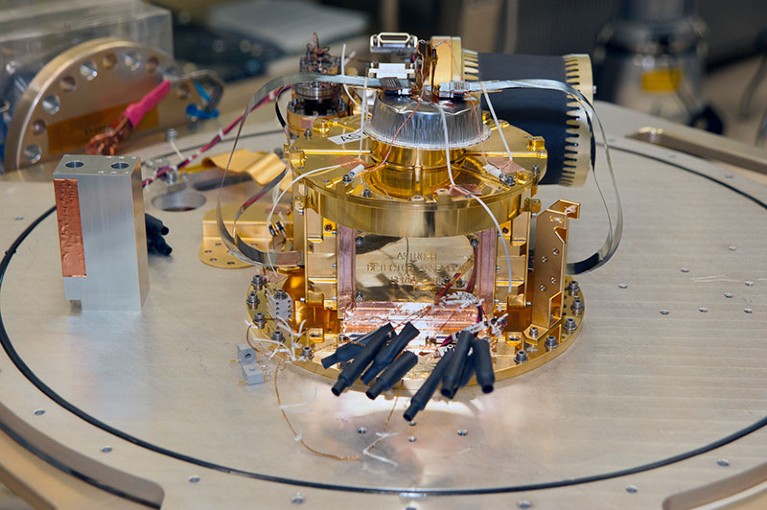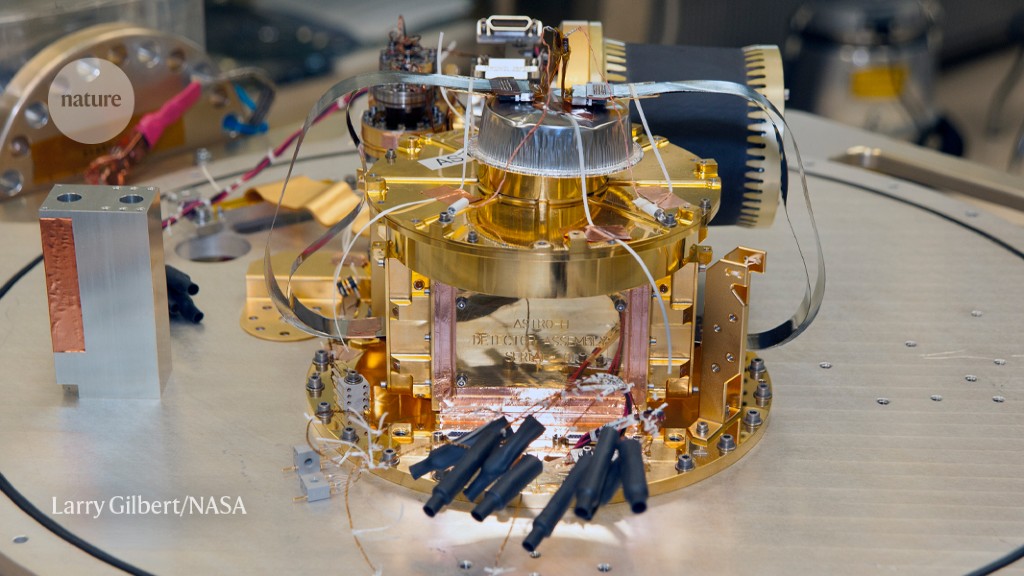
The XRISM calorimeter will register X-rays from deep space. Part of the device was built using parts from the ill-fated Hitomi mission, as can be seen by the engraved “ASTRO-H” — an earlier name for the mission.Credit: Larry Gilbert/NASA
Astronomers will be on the edge of their seats this Sunday, when a long-awaited space mission is due to begin. The X-Ray Imaging and Spectroscopy Mission (XRISM, pronounced ‘crism’) will launch at 9.30 am local time on an H-IIA rocket from Tanegashima Space Center in Japan. The mission aims to observe X-rays coming from deep space and to identify their wavelengths with unprecedented precision.
These capabilities will give researchers insights into astrophysical phenomena ranging from how clusters of galaxies form to how black holes generate jets of high-energy particles.
The science will be “very exciting — for me and, I believe, for other X-ray astronomers”, says Makoto Tashiro, an X-ray astronomer at Saitama University who is XRISM’s principal investigator. XRISM, a joint mission of the Japan Aerospace Exploration Agency (JAXA) and NASA, with a further contribution from the European Space Agency (ESA), is expected to operate for around three years.
The same rocket will also launch the Smart Lander for Investigating Moon (SLIM), which aims to demonstrate the capability of landing at a precisely chosen site on the lunar surface. If successful, it will be the first JAXA mission to land on the Moon.
XRISM’s unique feature will be its X-ray calorimeter, a technology developed at NASA in the 1980s that detects electromagnetic radiation through changes in temperature in the order of millionths of a degree. The energies of individual X-ray photons are related to their wavelengths, and knowing this will enable astronomers to distinguish the signatures of chemical elements, helping astrophysicists to reconstruct the history of the cosmos.
XRISM’s calorimeter will be also able to take spectra of extended objects, including intergalactic gas and black-hole accretion disks. This sets it apart from existing X-ray observatories, which can take spectra only of pointlike sources, such as individual stars. For X-ray sources that are in motion, spectra will be shifted by the Doppler effect — revealing, for example, whether a cluster of galaxies formed from the merger of two smaller clusters.
Intergalactic matter is also often stirred by jets of matter produced by supermassive black holes that lie at the centres of galaxies. Mapping these maelstroms could help astrophysicists to understand the mysterious origins of the jets and how they affect galaxy evolution.
Fourth time lucky?
XRISM will be Japan’s fourth attempt to deploy an X-ray calorimeter in space. The first was in 2000, when the satellite carrying the instrument crashed shortly after lift-off. Five years later, a calorimeter aboard the Suzaku probe became inoperable when it lost the helium that was supposed to keep its sensors at close to absolute zero.
Then, in February 2016, JAXA launched ASTRO-H, later renamed Hitomi. Only five weeks later, while the instruments were still undergoing calibration and tests, a software error caused the spacecraft to spin out of control and break apart.
To speed up the development and construction of XRISM, the team decided to simplify its payload. Gone was Hitomi’s second telescope, which would have imaged objects using ‘hard’, or high-energy, X-rays, a capability that is already present in NASA’s NuSTAR. Instead, the mission decided to focus on lower-energy, ‘soft’ X-rays, and in particular on the calorimeter, which was the feature that the astronomy community needed most urgently, says Tashiro. The Earth’s atmosphere blocks X-rays, so the only way for astronomers to see this part of the electromagnetic spectrum is to go into space, and XRISM’s capabilities will be unique until ESA launches its Athena space observatory — carrying a more sophisticated version of the calorimeter — in 2035.
Astronomers got a taste of these possibilities during Hitomi’s short life. While its X-ray calorimeter was still covered by a lid that was meant to protect it from the air until after launch, mission scientists used it to map the intergalactic gas in the Perseus Cluster, the galaxy cluster that is brightest in X-rays. “It was just, ‘Let’s try to point it and see what we see,’” says Irina Zhuravleva, an astrophysicist at the University of Chicago in Illinois who is on XRISM’s science team, and who took part in the Hitomi study.
“The initial rumours of what was being seen in the source spectra, even before the final thin window on the detector was opened, were thrilling,” says Christine Jones, an astrophysicist at the Harvard–Smithsonian Center for Astrophysics in Cambridge, Massachusetts.
The results, which were published in 20161, were “really, really spectacular,” says Zhuravleva. If anything, the real data were more detailed than theoretical predictions. “We found that our models were missing some lines. Our first surprise was how incomplete our understanding was of simple atomic transitions.” This has also sparked renewed interest in studying plasmas in a laboratory setting, she adds.
Hitomi showed that the gas in the Perseus Cluster is moving at surprisingly low speeds of less than 200 kilometres per second. One big question is whether the same is true of other galaxy clusters, or whether Perseus is an outlier. “We are finally, hopefully, opening an absolutely new era in X-ray astronomy,” says Zhuravleva.






More News
Editorial Expression of Concern: Leptin stimulates fatty-acid oxidation by activating AMP-activated protein kinase – Nature
Quantum control of a cat qubit with bit-flip times exceeding ten seconds – Nature
Venus water loss is dominated by HCO+ dissociative recombination – Nature